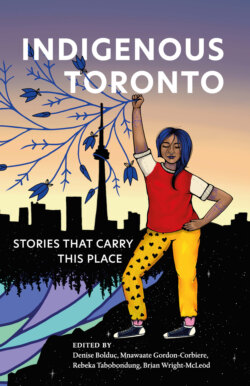Читать книгу Indigenous Toronto - Группа авторов - Страница 16
На сайте Литреса книга снята с продажи.
THE MOATFIELD VILLAGE AND OSSUARY
ОглавлениеSituated on a small tributary of the Don River about twelve kilometres from Lake Ontario, just south of Highway 401, the Moatfield village would have involved planning and a great deal of hard work during its construction. The villagers had to clear the one-hectare settlement area and its surrounding hardwood forest, dominated by maple and beech, for a distance of about eight hundred metres to establish agricultural fields. They then used thousands of the felled saplings to construct their houses, covering them with elm and cedar bark. Smoke holes would have been placed in their roofs to encourage some of the smoke to escape from the winter heating and cooking hearths. Later descriptions of these houses by European settlers all depict a four-foot smoke ceiling, making standing up for any longer than a few seconds impossible.
Figure 3: Map of Moatfield Ossuary, Level 1.
A portion of a longhouse was found along with the remains of thirty-two ceramic cooking vessels, all of them consistent with forms and designs used seven hundred years ago. The ossuary was situated on the edge of the village, perhaps adjacent to the palisade.
As the ancestors had been mixed together when the ossuary was created, they were removed bone by bone. Examination of each allowed for a determination of the age, gender, and health of the ancestors. Diets were scrutinized using a single molar per person for carbon isotopic analysis, which produces a measure of the amount of corn consumed versus other naturally occurring local plants. Permission to examine each bone and to retain one tooth for each individual was granted by Six Nations Council at the time of the excavation.
The ancestors had been placed in the ossuary pit after varying amounts of decomposition had occurred in their primary burials. Body parts as complete as entire torsos were sometimes included. An absence of weathering on the surface of the bones suggests that ancestors were initially buried quickly, then years later interred in the ossuary in small groupings, perhaps families, and then covered quickly (Figure 3).
A thick layer of soil between two large concentrations of bone pointed to its creation in at least two separate episodes. There were no bones from the same individual found across this boundary and there was evidence that the top level contained the remains of the more recent deaths from the community.
Most of the skeletal remains had likely been removed from any wrappings prior to their deposition. Some of the bones had been manually arranged – in particular crania. Almost 30 per cent of the crania were placed near the top of the ossuary, many in groups of two to four skulls. There was no age- or sex-based patterning of the position of the crania or any of the other bones.
To refine the age of the site that had initially been estimated on the basis of artifact styles, a series of accurate radiocarbon dates was obtained on corn remains from the village and on bone fragments from within the ossuary. These indicate that the village and the ossuary are contemporary and date to around seven hundred years ago. This is the earliest ancestral Huron-Wendat community ossuary in southern Ontario. It is also the most thoroughly investigated ossuary.
